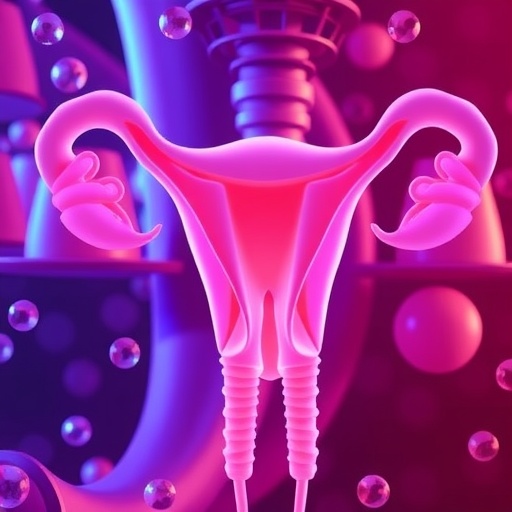Recent research has revealed a concerning and intricate relationship between bisphenol A (BPA), an industrial chemical prevalent in plastics, and ovarian cancer, a leading cause of gynecological malignancies worldwide. It is well established that various environmental factors contribute to the development of cancer, but the specifics surrounding BPA’s role in ovarian carcinogenesis have remained unclear until now. A pioneering study conducted by Shi, Li, and Yang pushes the boundaries of our understanding by combining network toxicology with Mendelian randomization analysis to investigate the potential causal pathways influenced by BPA, particularly focusing on the CTRC/PRDX1/SKP1 signaling network.
As an endocrine disruptor, BPA mimics the action of estrogen in the body, which has raised alarms regarding its potential to instigate hormonal imbalances. This study meticulously explores how such imbalances may trigger oncogenic processes in ovarian cells. The researchers utilized sophisticated epidemiological methods to analyze genetic data linked to BPA exposure, providing a multi-faceted view of the chemical’s potential health effects. The melding of these innovative approaches offers a rich tableau of evidence that could redefine our understanding of environmental carcinogens.
In the era of personalized medicine, the importance of genetic predisposition in disease development cannot be overstated. By employing Mendelian randomization, the authors have created a framework allowing for causal inferences to be drawn from observational data. This is particularly pertinent when investigating BPA, as the research navigates the biases often encountered in retrospective analyses. Such methodological rigor elucidates the role of specific genetic variations coupled with BPA exposure, thereby isolating the potential mechanisms leading to ovarian cancer.
Central to the investigation is the CTRC/PRDX1/SKP1 pathway, a molecular network that has garnered attention for its involvement in cellular stress responses and apoptosis regulation. The study delves into how BPA might modulate this pathway, potentially resulting in aberrant cell survival and proliferation. By tracing the biological routes influenced by BPA, the research establishes a plausible link between environmental exposures and the molecular underpinnings of ovarian cancer, a relationship that has been elusive in prior studies.
Additionally, the authors provide a thorough examination of the biological plausibility of BPA’s involvement in ovarian carcinogenesis. This includes the exploration of oxidative stress mechanisms and the disruption of redox homeostasis that could ensue from prolonged BPA exposure. Consequently, the researchers argue that sustained oxidative stress may lead to genetic mutations and epigenetic modifications, setting the stage for malignant transformation within ovarian tissues.
The implications of these findings are profound. Given the ubiquity of BPA in consumer products—from food containers to thermal receipts—understanding its role in ovarian cancer hazard assessment is crucial. The research thus underscores the urgent need for regulatory bodies to re-evaluate the acceptable limits of BPA exposure, especially for populations at heightened risk of developing ovarian malignancies, such as women of reproductive age.
Moreover, the findings highlight the complexity of cancer etiology, emphasizing that not all women are uniformly susceptible to BPA’s carcinogenic effects. The intricate interplay between environmental factors and genetic predispositions suggests a need for personalized risk assessment strategies that consider individual genetic backgrounds in relation to BPA exposure. This could lead to targeted preventative measures for those who may be more affected by environmental toxins.
Furthermore, the study serves to bridge the gap between laboratory research and clinical application. By validating the CTRC/PRDX1/SKP1 pathway as a potential biomarker for BPA exposure, future research may pivot towards developing diagnostic tools to identify individuals at risk. This could revolutionize early detection strategies for ovarian cancer, ultimately improving patient outcomes through timely interventions.
As this research gains traction, further investigations could extend the findings to assess the implications of other endocrine-disrupting chemicals (EDCs). The insight gained from this study could serve as a precursor for evaluating the cumulative effects of EDCs on ovarian health, leading to a more comprehensive understanding of environmental interactions related to cancer development.
In conclusion, this research is a significant step forward in elucidating the intricacies of how BPA may contribute to ovarian carcinogenesis. The systematic use of network toxicology intertwined with Mendelian randomization presents a novel methodology for uncovering the causal relationships between environmental exposures and cancer. As the scientific community continues to unravel the complexities of cancer biology, studies like this emphasize the critical intersection of environmental health and genetic factors, informing future strategies for prevention and intervention in ovarian cancer.
Ultimately, the call for enhanced awareness regarding BPA and its potential hazards cannot be overstated. As consumers, healthcare professionals, and policymakers absorb these findings, the hope is that it will catalyze action towards reducing BPA exposure in everyday life, thereby mitigating its potential impacts on women’s health worldwide.
Subject of Research: The potential causal link between BPA and ovarian carcinogenesis.
Article Title: Investigating the potential causal link between BPA and ovarian carcinogenesis: a network toxicology and mendelian randomization study on the CTRC/PRDX1/SKP1 pathway.
Article References:
Shi, Z., Li, Z. & Yang, F. Investigating the potential causal link between BPA and ovarian carcinogenesis: a network toxicology and mendelian randomization study on the CTRC/PRDX1/SKP1 pathway.
J Ovarian Res 18, 227 (2025). https://doi.org/10.1186/s13048-025-01814-z
Image Credits: AI Generated
DOI:
Keywords: BPA, ovarian cancer, endocrine disruptors, Mendelian randomization, network toxicology, CTRC, PRDX1, SKP1, carcinogenesis, oxidative stress, genetic predisposition, environmental toxins, women’s health.




